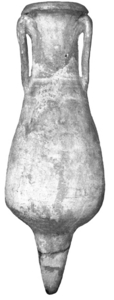Roman Amphorae: a digital resource
University of Southampton, 2005. (updated 2014) https://doi.org/10.5284/1028192. How to cite using this DOI
Data copyright © University of Southampton unless otherwise stated
This work is licensed under the ADS Terms of Use and Access.
Primary contact
Dr
David
Williams
Dept of Archaeology
University of Southampton
Avenue Campus
Highfield
Southampton
SO17 1BJ
England
Tel: 080 593032
Resource identifiers
- ADS Collection: 463
- DOI:https://doi.org/10.5284/1028192
- How to cite using this DOI
Beltrán 2A

Courtesy of Museu Arqueològic de Barcelona
David Peacock
Distinctive FeaturesThis has a broad, long and cylindrical or flared neck, with a wide and hooked rim, long flattened recurved handles and an ovoid body which widens towards the base and ends in a long, hollow, sharp spike (Beltrán Lloris, 1970; Peacock & Williams,1986). The form can be subdivided into other forms that are dependent upon the size of the vessel. The larger form is generally called Beltrán 2 A1 or Pelichet 46, while the smaller form is known as Beltrán 2-A2 or Augst 29.Minimum height. Larger shape: 90 cms. Smaller shape: 80 cms. Maximum height. Larger shape: 110 cms. Smaller shape: 90 cms. Minimum width. Larger shape: 35 cms. Smaller shape: 25 cms. Maximum width. Larger shape: 40 cms. Smaller shape: 30 cms. Minimum rim diameter. Larger shape: 20 cms. Smaller shape: 20 cms Maximum rim diameter. Larger shape: 25 cms. Smaller shape: 25 cms. See characteristics | ||
Date RangeProbably from the last years of the Augustan period to the middle of the second century AD (Beltrán Lloris, 1970; Peacock, 1974). Earliest date: c. AD 10-15 Latest date: Mid second century ADSearch: [1st century BC] [1st century AD] [2nd century AD] | ||
OriginBeltrán 2A was manufactured at many workshops in the modern southern Spanish provinces of Huelva, Cádiz, Málaga and Granada (Beltrán Lloris, 1970; Ponsich, 1988; Lagóstena, 1996), although production was most abundant in Cádiz.Workshops have been located in the following modern provinces of southern Spain. Huelva:Las Naves (Almonte), El Rompido (Cartaya). Cádiz: Fuente Redonda (Barbate), Venta del Carmen (Los Barrios), El Olivar (Chipiona), La Sangarriana, El Tesorillo (Jerez de la Frontera), Cantarranas, Palomar, La China, La Florida, Laguna Salada, Los Tercios (El Puerto de Santa María), El Almendral, La Cabaña 2, La Cachucha, Cantera de Lavalle II, Las Canteras, El Carpio Chico, Casa de la Tinaja, Cerería, Fábrica Lavalle, Olivar de los Valencianos, Puente Melchor, Torrealta A, Villanueva (Puerto Real), Gallineras, Albardonero 24, Fadricas, Gallineras, Huerta del Obispo (San Fernando), Guadarranque, Villa Victoria (San Roque), Loma del Chorrillo (Vejer). Málaga: Finca El Secretario (Fuengirola), C/Carretería, Paseo de los Tilos, Puente Carranque (Málaga), Huerta del Rincón (Torremolinos). Granada: Loma de Ceres (Molvízar). Search: [North West Europe] [Spain] [Western Mediterranean] | ||
DistributionWestern Roman provinces, the German limes, north Africa, and the eastern Mediterranean region. Known find spots include: Augst, Vindonissa, Mainz, Colchester, Hofheim, Strasbourg, St. Albans, Roi, Agde, Caerleon, Albintimilium, Rome, Cartagena, Empúries (Beltrán Lloris,1970), Nyon, Ostia, Lisbon, Venice, Padua, Coruña, Lugo, Santa Tecla, Carvalheiras, Bracara Augusta, Betoño, Tiermes, Complutum, Lleida, Casa Blanc, Alella, Mataró, Caldes de Montbui, Tarrasa, S. Just. Gavá, El Francas, Can Roig, Arenys, Torre Llauder, Sent Romá, Masnou, Badalona, Les Sorres, V. Panadés, Sagunto, Almanzora, Valencia, Duanes, Jávea, Tossal de Manises, Ilici, Santa Pola, Mazarrón (Beltrán Lloris, 2000), Illuro; Ceuta, Mogador; Tibiscum, Ulpia Traiana Sarmigezetusa, Corinth, Gortina, Tarss, Berytus, Caesarea Maritima (Bernal Casasola, 2000).Search: [Eastern Mediterranean] [Germany] [Great Britain] [Italy] [North Africa] [North West Europe] [Spain] [Switzerland] [Western Mediterranean] | ||
ContentsThis type carried a range of fish-based products (Zevi,1966; Beltrán Lloris, 1970) including:g(arum) sc(ombri) (flos) ex(cellens) ve(tus), from a titulus pictus found at Augst. garum vetus flos excellens summaur, from a titulus pictus found at Fréjus. liqu(uamen) mulli summaur flos, from a titulus pictus found at Fréjus. miscell(um) por(tuense) vel miscell(anea) port(uensis) mus( ) excellens, from a titulus pictus found at Fréjus. cordyla arguta excellens, from a titulus pictus found at Fréjus. (inscription found in Alésia). cordyla portuensis vetus, from a titulus pictus found at Fréjus. (inscription found in Alésia). cordyla arguta vetus excellens summaur annorum quattuor, from a titulus pictus found at Saintés allex recens lectum AA, from a titulus pictus found at Mainz. liqu(amen) excel(lens) (s)umm(um), from a titulus pictus found in Almería. Search: [Fish Sauce] | ||
CommentsPrincipal contributor: Lazaro Lagóstena | ||
ClassificationAugst 27Augst 29 Callender 6 Camulodunum 186C Dressel 38 Peacock & Williams 18 Pélichet 46 | ||
CEIPAC linkThe following link will take you to the Centro para el Estudio de la Interdependencia Provincial en la Antiguedad Clásica CEIPAC database. In the CEIPAC system this amphora has the ID KE51+BYZ. Note: access to CEIPAC requires registration, which is possible via http://ceipac.ub.edu/corpus_reg.php?IDM=e | ||



 3D models
3D models


